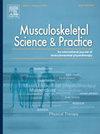使用机器学习预测与妊娠相关的骨盆带疼痛
IF 2.2
3区 医学
Q1 REHABILITATION
引用次数: 0
摘要
妊娠相关性骨盆带痛(PPGP)是妊娠期常见的并发症,对孕妇的生活质量产生负面影响。有许多与PPGP相关的危险因素,然而,关于能够预测PPGP诊断的信息有限。目的比较机器学习(ML)与传统预测模型对PPGP临床诊断的预测价值。方法本研究重新分析了780名在三级医院就诊的孕妇的资料。采用Logistic回归(LR)、随机森林(Random Forest)、Xtreme Gradient Boost (XGBoost)和K-Nearest Neighbors等ML算法预测PPGP的临床诊断。以受试者工作特征曲线下面积(Area Under the Receiver Operating Characteristic Curve, AUROC)为主要指标,采用特征选择和交叉验证方法优化模型性能。结果ML模型,特别是XGBoost和LR,显示出较高的预测准确性(AUROC = 0.70)。主要预测因素为妊娠前腰痛/骨盆带痛(LBP/PGP)史、家族史、胎龄、白天站立时间较长。以前妊娠的LBP/PGP病史是最重要的预测因子。本研究强调了ML模型在提高PPGP预测能力方面的潜力,并提供了一种更准确、更全面的方法来识别有PPGP风险的女性。将ML技术整合到临床实践中可以改善早期识别,并为预防和干预策略提供信息,潜在地减少PPGP对孕妇的影响。本文章由计算机程序翻译,如有差异,请以英文原文为准。
Predicting pregnancy-related pelvic girdle pain using machine learning
Background
Pregnancy-related pelvic girdle pain (PPGP) is a common complication during gestation which negatively influences pregnant women's quality of life. There are numerous risk factors associated with PPGP, however, there is limited information about being able to predict the diagnosis of PPGP.
Objective
To compare machine learning (ML) and traditional predictive modelling to predict the clinical diagnosis of PPGP.
Methods
This study reanalysed data from 780 pregnant women attending a tertiary hospital. ML algorithms, including Logistic Regression (LR), Random Forest, Xtreme Gradient Boost (XGBoost), and K-Nearest Neighbors, were used to predict the clinical diagnosis of PPGP. Feature selection methods and cross-validation were employed to optimize model performance, with the Area Under the Receiver Operating Characteristic Curve (AUROC) as the primary outcome measure.
Results
The ML models, particularly XGBoost and LR, demonstrated high levels of predictive accuracy (AUROC = 0.70). Key predictive factors were a history of low back pain/pelvic girdle pain (LBP/PGP) in previous pregnancies, family history, gestational age, and a longer duration of standing during the day. The history of LBP/PGP in previous pregnancies emerged as the most significant predictor.
Conclusions
This study highlighted the potential of ML models to enhance the ability to predict PPGP and offers a more accurate and comprehensive approach to identifying women at risk of PPGP. The integration of ML techniques into clinical practice could improve early identification and inform preventative and intervention strategies, potentially reducing the impact of PPGP on pregnant women.
求助全文
通过发布文献求助,成功后即可免费获取论文全文。
去求助
来源期刊

Musculoskeletal Science and Practice
Health Professions-Physical Therapy, Sports Therapy and Rehabilitation
CiteScore
4.10
自引率
8.70%
发文量
152
审稿时长
48 days
期刊介绍:
Musculoskeletal Science & Practice, international journal of musculoskeletal physiotherapy, is a peer-reviewed international journal (previously Manual Therapy), publishing high quality original research, review and Masterclass articles that contribute to improving the clinical understanding of appropriate care processes for musculoskeletal disorders. The journal publishes articles that influence or add to the body of evidence on diagnostic and therapeutic processes, patient centered care, guidelines for musculoskeletal therapeutics and theoretical models that support developments in assessment, diagnosis, clinical reasoning and interventions.
 求助内容:
求助内容: 应助结果提醒方式:
应助结果提醒方式:


